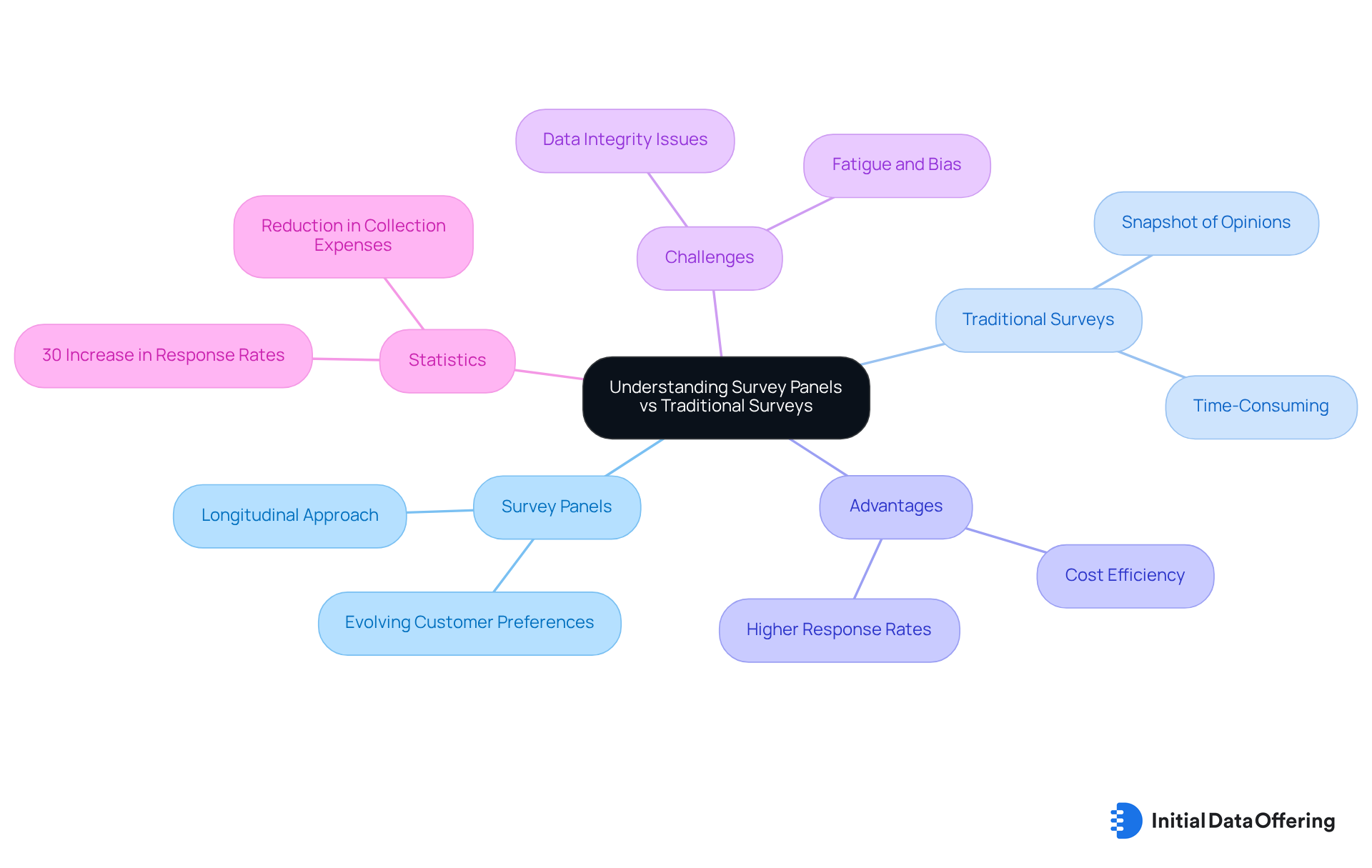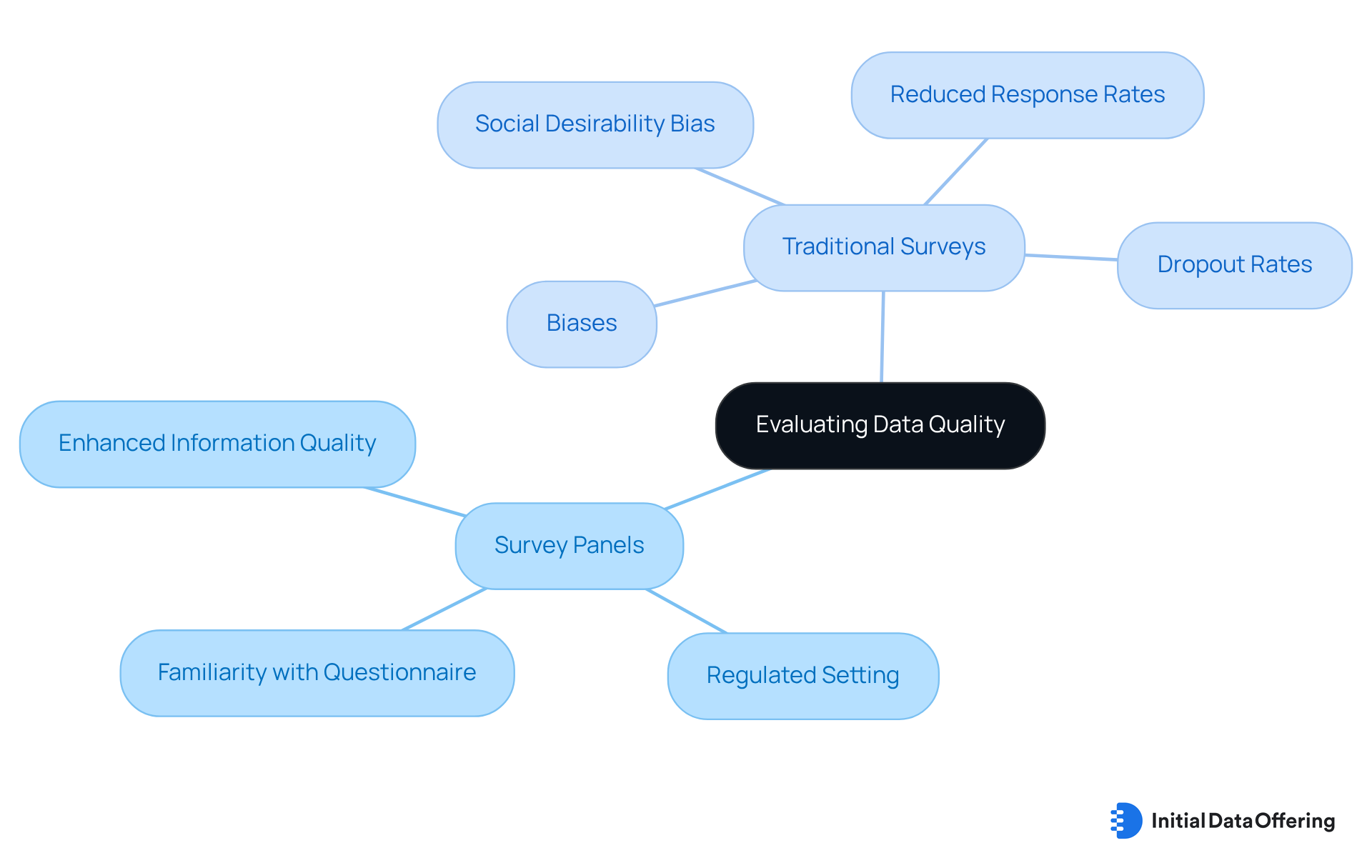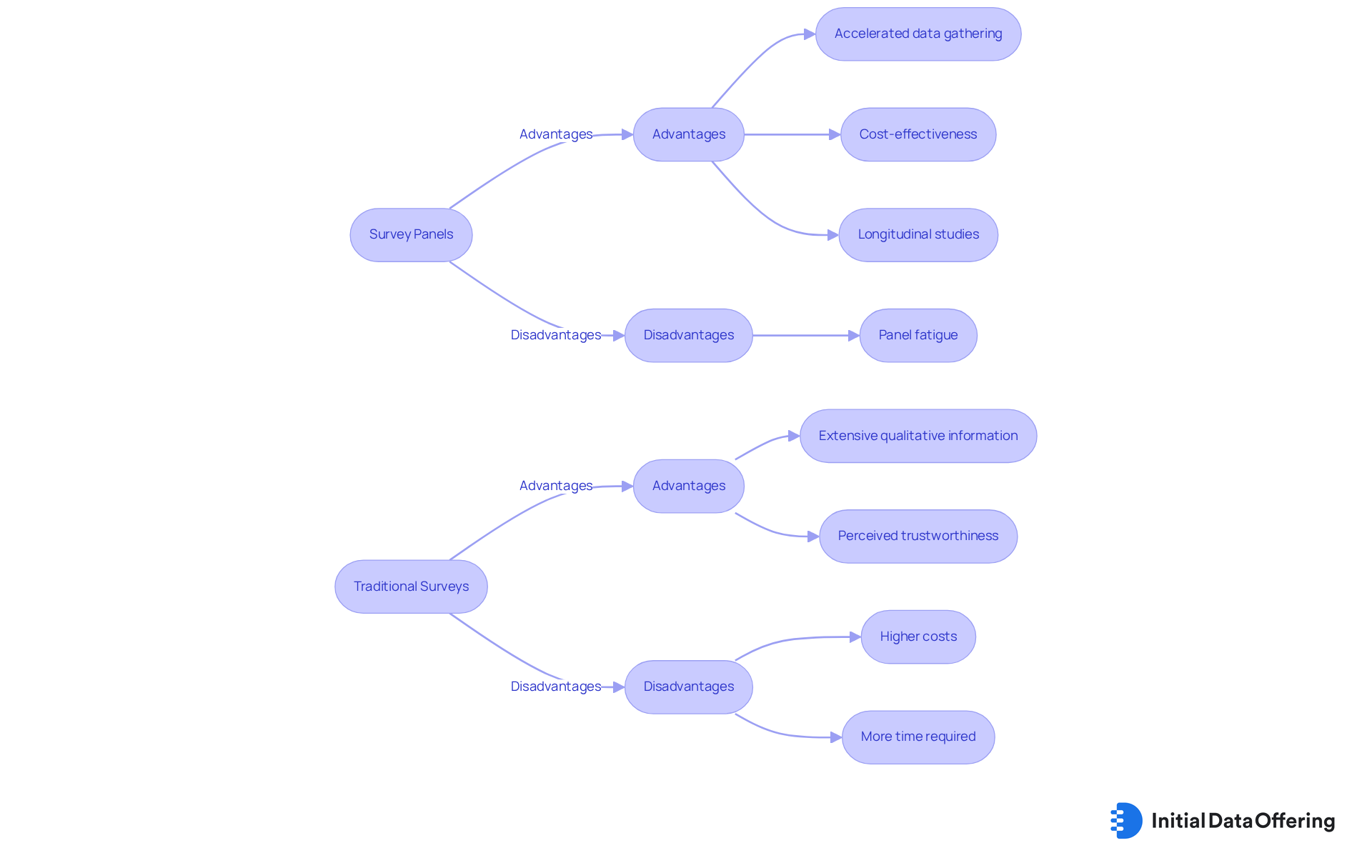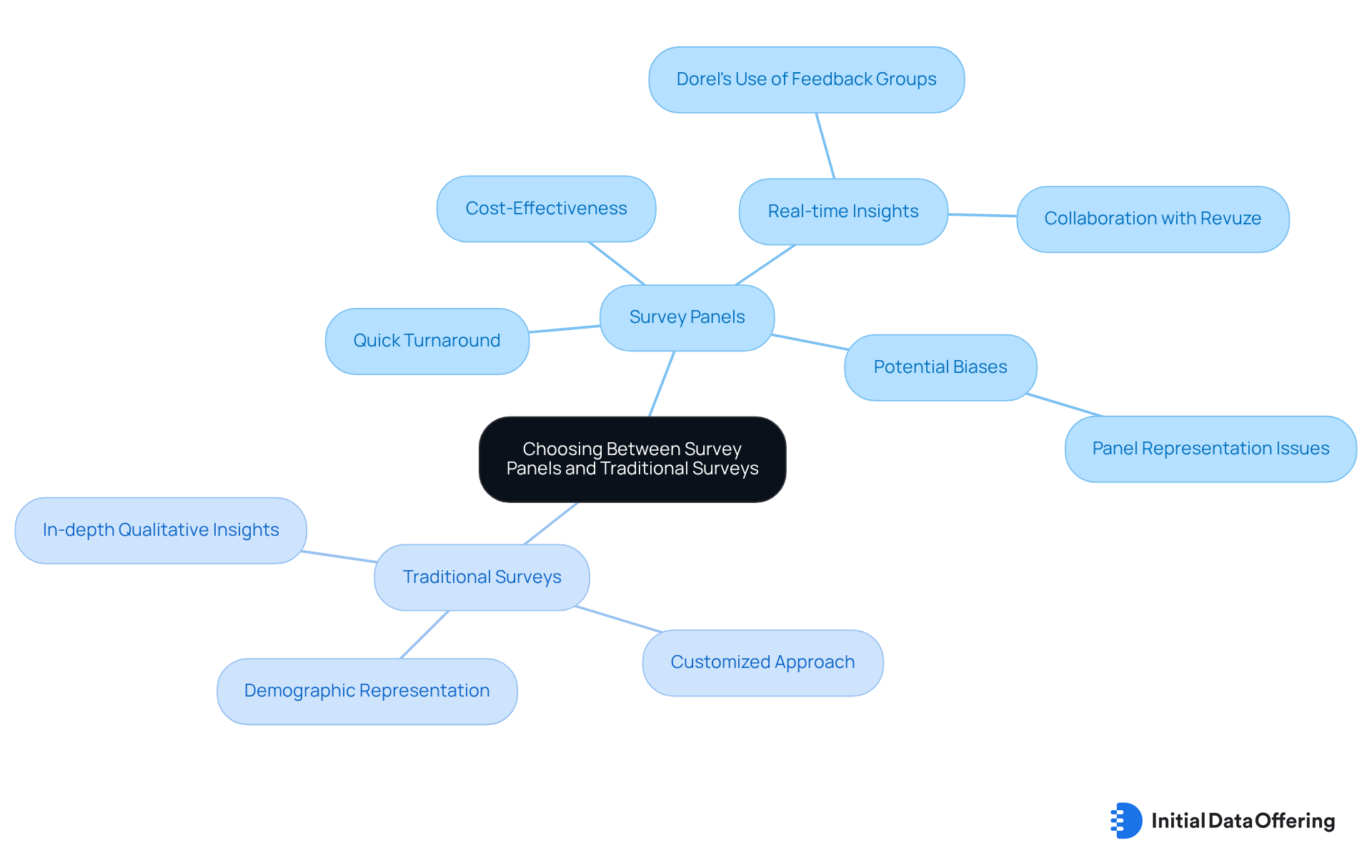Survey Panel vs. Traditional Surveys: Key Insights for Analysts

Survey Panel vs. Traditional Surveys: Key Insights for Analysts
Overview
This article provides a comparative analysis of survey panels and traditional surveys, emphasizing their distinct characteristics. Survey panels offer longitudinal insights and cost-effectiveness, making them a favorable option for many researchers. In contrast, traditional surveys can yield in-depth qualitative data, but they often require a higher cost and greater time investment. This distinction is underscored by evidence showing that survey panels typically achieve improved response rates and enhanced data quality. Such efficiency in capturing evolving consumer sentiments is crucial for informed decision-making in market research.
The benefits of utilizing survey panels extend beyond mere cost savings; they also facilitate a deeper understanding of consumer behavior over time. By leveraging the longitudinal data provided by survey panels, researchers can track changes in consumer sentiment and preferences, which is vital for adapting marketing strategies. As businesses strive to remain competitive, the ability to access timely and relevant insights becomes increasingly important.
In conclusion, while traditional surveys have their place in qualitative research, the advantages of survey panels—such as cost-effectiveness and improved response rates—make them a compelling choice for market researchers seeking to understand and respond to consumer needs effectively. How can you leverage these insights in your own research practices to enhance decision-making and strategy development?
Introduction
The landscape of market research is evolving, prompting analysts to increasingly weigh the merits of survey panels against traditional surveys.
- Survey panels, characterized by their longitudinal approach, capture shifts in consumer behavior over time, providing valuable insights into trends.
- In contrast, traditional surveys offer a snapshot of opinions, which can be invaluable for specific inquiries.
As organizations strive for accuracy and cost-effectiveness in their data collection methods, the question arises: how do these differing methodologies impact the reliability and richness of insights gathered? Understanding the nuances between these approaches is essential for analysts seeking to enhance their research outcomes in a rapidly changing environment. By considering both methodologies, analysts can better tailor their strategies to meet the demands of the market.
Understanding Survey Panels and Traditional Surveys
A survey panel consists of a pre-recruited group of individuals who agree to participate in questionnaires over time, facilitating a longitudinal approach to information gathering. This method allows researchers to observe changes in attitudes and behaviors among the same respondents, thus offering deeper insights into trends and shifts. In contrast, conventional questionnaires typically involve single-instance information gathering techniques, such as in-person interviews or phone polls, which capture a snapshot of opinions at a specific moment. These traditional methods are often more time-consuming and costly, necessitating extensive recruitment and scheduling efforts.
The efficacy of research groups is underscored by their ability to yield more comprehensive information over time using a survey panel. For instance, longitudinal research utilizing a survey panel can reveal how customer preferences evolve, providing brands with the opportunity to adjust their strategies accordingly. By 2025, the advantages of research groups are increasingly recognized, with market research analysts noting that they deliver more reliable insights compared to conventional questionnaires. As Nic Newman, a journalist and digital strategist, points out, understanding the customer is crucial for marketing success, and feedback groups facilitate this understanding through ongoing interaction.
Moreover, statistics indicate that organizations employing research groups experience a significant reduction in collection expenses while achieving greater accuracy in their results. For example, organizations utilizing feedback groups have reported response rates increasing by as much as 30%, demonstrating their efficiency in gathering quality information. This is particularly important as companies strive to maintain information integrity in an era where high-quality data is essential for informed decision-making. By leveraging the advantages of a survey panel, investigators can ensure that their insights are not only timely but also reflective of current consumer sentiments. However, it is crucial to acknowledge that research groups may face challenges such as fatigue or bias over time, which can impact the reliability of the information collected. Therefore, while research groups offer numerous benefits, scholars must remain vigilant to these potential limitations.

Evaluating Data Quality: Survey Panels vs. Traditional Surveys
Panel studies conducted through a survey panel typically offer enhanced information quality due to their regulated setting and the respondents' familiarity with the questionnaire process. This familiarity is a key feature, as it motivates panelists to provide insightful responses, resulting in more trustworthy information. In contrast, traditional surveys often encounter biases, such as social desirability bias, where respondents may opt for answers they perceive as more socially acceptable rather than expressing their true opinions.
Furthermore, conventional techniques frequently face challenges, including reduced response rates and increased dropout rates, which can jeopardize the quality of information gathered. Evaluating these aspects is crucial for analysts who aim to derive actionable insights from their research.
How can the differences between panel studies and traditional surveys impact your research outcomes? Understanding these dynamics allows analysts to make informed decisions about methodology, ultimately enhancing the reliability of their findings. By recognizing the benefits of a survey panel, researchers can leverage this approach to gather richer, more accurate data, thereby improving the overall quality of their research efforts.

Pros and Cons: Practical Applications of Each Survey Method
Survey panels offer distinct features, including accelerated data gathering, cost-effectiveness, and the capability to conduct longitudinal studies. These advantages make them particularly effective for tracking changes over time and extracting insights from specific demographic groups.
However, one must consider the challenges that a survey panel presents; for instance, panel fatigue can diminish respondent engagement over time. In contrast, traditional surveys are known for generating extensive qualitative information and are often perceived as more trustworthy by participants. Despite their reliability, these surveys typically incur higher costs and require more time, which may limit their applicability in projects that necessitate quick insights.
As Ryan Smith, Founder of Qualtrics, aptly notes, "Companies don't need more information; they need varied information," underscoring the critical nature of selecting the appropriate data collection method. Analysts should meticulously evaluate these advantages and disadvantages to ensure their research methodologies align with their specific objectives, especially in a climate where the demand for timely and actionable data is ever-increasing.
Moreover, the focus on curating unique datasets, as exemplified by platforms like Initial Data Offering (IDO), underscores the necessity for targeted insights that can foster innovation and strategic planning across various industries.

Recommendations for Choosing Between Survey Panels and Traditional Surveys
When selecting between research groups and conventional questionnaires, analysts must thoroughly assess their research goals, budget limitations, and project schedules. Research groups offer distinct features that can be particularly advantageous for projects requiring quick turnaround and cost-effectiveness. These benefits make them suitable for continuous research, which monitors changes over time. For instance, organizations like Dorel Juvenile have effectively utilized feedback groups to gather real-time consumer insights. This approach has enabled them to enhance product features and bolster safety measures based on prompt responses. Their collaboration with Revuze has democratized access to consumer insights across various teams, fostering a more responsive approach to customer needs and improving product safety by swiftly addressing quality concerns.
In contrast, traditional surveys may be more fitting when the goal is to obtain in-depth qualitative insights or when the target population is underrepresented in existing survey panels. This technique allows for a customized approach, ensuring specific demographic segments are adequately represented. Analysts should also consider potential biases and quality concerns inherent in each method. For example, while a survey panel can provide quick insights, it may introduce biases if the panel does not accurately reflect the broader population. Dorel's strategy for consumer feedback has been instrumental in addressing these concerns, ensuring that their information-gathering techniques uphold the integrity and reliability essential for informed decision-making.
Ultimately, the selection of approach should align with the integrity and reliability of the data necessary for informed decision-making. As market research specialists emphasize, aligning research techniques with objectives is crucial for obtaining significant results. Diane Meyer, VP of Consumer Experience, noted, "It’s important to ensure we’re listening to what customers are saying, particularly around safety." By weighing these factors, including budget considerations for 2025, analysts can select the most appropriate survey panel method to fulfill their specific research needs.

Conclusion
Survey panels and traditional surveys each present distinct features, advantages, and challenges that can significantly influence research outcomes. The decision between these methodologies depends on the specific research goals, the depth of insights sought, and the resources at hand. By recognizing the strengths of survey panels—such as their capacity to deliver longitudinal data and improved accuracy—researchers can utilize these tools to gather richer, more actionable insights.
Key arguments emphasize that survey panels not only streamline the data collection process but also enhance the quality of information gathered over time. Conversely, traditional surveys, while valuable for in-depth qualitative insights, often encounter challenges like higher costs and potential biases. Analysts must carefully consider these elements, weighing the implications of each method on data integrity and reliability.
Ultimately, the decision-making process should align with the overarching goal of obtaining high-quality, relevant data to inform strategic decisions. As market research continues to evolve, embracing the strengths of survey panels while remaining aware of their limitations will empower analysts to navigate the complexities of consumer insights effectively. The future of research methodologies lies in making informed choices that reflect the dynamic landscape of consumer behavior and preferences.
Frequently Asked Questions
What is a survey panel?
A survey panel consists of a pre-recruited group of individuals who agree to participate in questionnaires over time, allowing for a longitudinal approach to information gathering.
How does a survey panel differ from traditional surveys?
A survey panel allows researchers to observe changes in attitudes and behaviors among the same respondents over time, while traditional surveys capture a snapshot of opinions at a specific moment through single-instance techniques like in-person interviews or phone polls.
What are the advantages of using survey panels for research?
Survey panels yield more comprehensive information over time, reveal how customer preferences evolve, and provide brands with the opportunity to adjust their strategies. They also help organizations reduce collection expenses and achieve greater accuracy in results.
What impact do survey panels have on response rates?
Organizations utilizing survey panels have reported response rates increasing by as much as 30%, demonstrating their efficiency in gathering quality information.
What challenges might research groups face when using survey panels?
Research groups may face challenges such as participant fatigue or bias over time, which can impact the reliability of the information collected.
Why is understanding the customer important for marketing success?
Understanding the customer is crucial for marketing success because it allows brands to tailor their strategies effectively, and feedback groups facilitate this understanding through ongoing interaction.
How do survey panels contribute to informed decision-making?
By leveraging the advantages of survey panels, investigators can ensure that their insights are timely and reflective of current consumer sentiments, which is essential for informed decision-making.